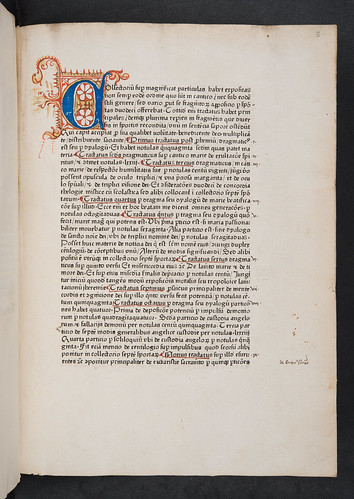Gerson, Johannes: Collectorium super Magnificat.
[Strassburg: Heinrich Eggestein?], 1473.
Fol. [12 2-1010 1112 12-1610 17-188]. [170] leaves (18/8 blank).
ISTC ig00199000; GW 10765; Goff G199; BMC II 512 (IB. 8911a); Bod-inc G-112; CIBN G-152; BSB-Ink G-135.050.
Note: CIBN and BSB-Ink tentatively attribute this edition to the Strassburg press of Heinrich Eggestein, following Kurt Ohly, ‘Eggestein, Fyner, Knoblochtzer. Zum Problem des deutschsprachigen Belial mit Illustrationen (Copinger 5804)’, in Gutenberg Jahrbuch (1962), pp. 122-35. Victor Scholderer in ‘Notes on the incunabula of Esslingen’, Gutenberg Jahrbuch (1950), pp. 167-71, at p. 168, noted the distinction from type 96 used by Conrad Fyner in Esslingen (to whom this edition is ascribed by Proctor, BMC, Goff and GW).
| GIP number: | G26 |
| Shelf-mark: | Sp Coll BD9-c.8 (see main library entry for this item) |
| Variant: | Final word on 8/10r (f. 72r) is ‘oꝑe’ as in Bod-inc copy 1, not ‘tꝑe’ as in BMC copy and Bod-inc copy 2. |
| Provenance: | Regensburg, Bavaria, Benedictines, S. Emmeramus: inscription on 1/1r “Monasterij S. Em[m]eramj Ratisbonae”; armorial bookplate on front pastedown “Ad Bibliothecam S. Em[m]erami I. O. G. D.” and signed “B.G. Fridrich sculps in Regensp.” Unidentified bookseller: extract from a bookseller’s catalogue relating to this copy pasted onto front pastedown “A remarkably fine and large copy, formerly belonging to the Abbey S. Emmeran” (details of item number and price not included). William Euing (1788-1874), insurance broker, Glasgow: source unknown; Euing’s acquisition date and price code in pencil “27 1 41 ca/f” on front pastedown, together with an early Euing inventory number “34”. University of Glasgow: presented by Euing in 1872 according to one of two University Library bookplates on front pastedown. |
| Binding: | Germany, 15th/16th-century, heavily worn blind-tooled pigskin over wooden boards; two brass clasps with catch plates on front cover; on each cover evidence from nail holes of four corner-pieces and one lozenge-shaped centre-piece - all now lost; formerly chained - staple-marks of a hasp at the head of the rear board with a fragment of parchment manuscript masking damage on the inside of the rear board. Covers heavily worn; the front cover has a foliate-roll border and a centre panel formed by fillets, which is divided from corner to corner to form four triangles and these are decorated with two separate lozenge-shaped stamps - a lozenge-shaped unicorn stamp and a lozenge-shaped floral(?) stamp, each stamp arranged in groups of four. The rear cover has the same foliate-roll border and a centre panel formed by fillets, which is divided by fillets into eight triangular compartments and these contain separate circular and lozenge-shaped stamps too worn to be identified. Pale yellow-edged leaves. Early manuscript title (worn) in red and black ink on a piece of paper mounted close to the top edge of the front cover; later manuscript title on paper added to top compartment of spine. 15th/16th-century paper pastedowns ruled in ink in two columns; small square patch of paper pasted onto front pastedown with a 15th/16th-century shelfmark or inventory number ‘54.2’, replacing a similar patch of paper with largely deleted shelfmark 21.8’(?)‘. Parchment leaf from a late medieval service book inserted at front with text beginning ‘& damiani et omniu[m] s[an]c[t]orum tuorv[m] quoru[m] meritis precibusq[ue] concedas ...’. Parchment manuscript guards visible in middle of each quire. Size: 303 × 218 mm. |
| Leaf size: | 291 x 213 mm. |
| Annotations: | Occasional marginal annotations in a 15th/16th-century hand; running headings in an early hand on most recto leaves “T[ra]ct[atus] j” - “T[ra]ct[atus] xij”; early manuscript title written on front pastedown “Gerson sup[er] magnificat ...”; evidence of early signatures and of numbering of quires in arabic numerals in lower margin; 19th-century price code “bb/-” in pencil on rear pastedown; two pages of 19th-century notes on this edition mounted on front flyleaf. |
| Decoration: | Six-line initial “C” on 2/1r (f. 3r) supplied in blue, the body of the letter filled with daisy-like decoration in red, yellow and reserved white, and with decoration in the same colours surrounding the letter; six-line initial “C” on 2/1v (f. 3v) supplied in red with a floral infill in green, red, yellow and reserved white, and with decoration in the same colours surrounding the letter; other initials supplied throughout in red or in red with reserved white, often with marginal flourishes; paragraph marks in red throughout. |
| Imperfections: | None. |







